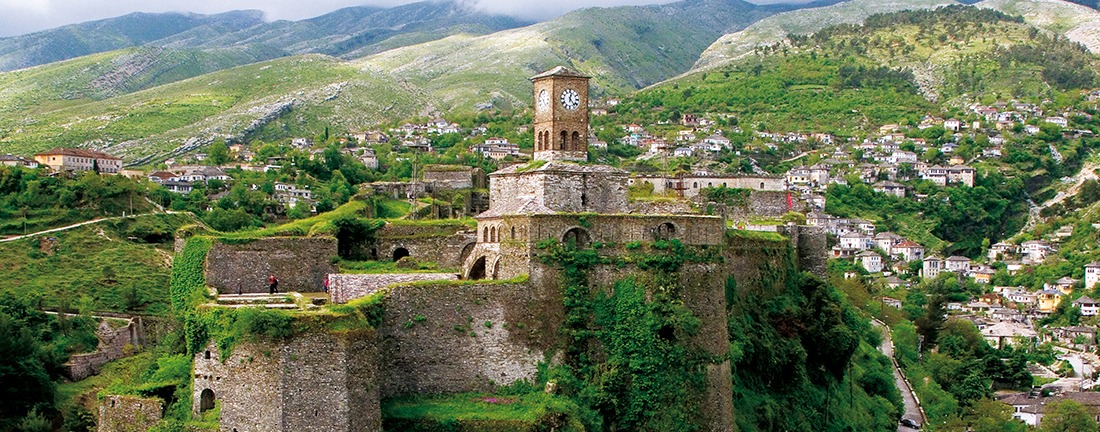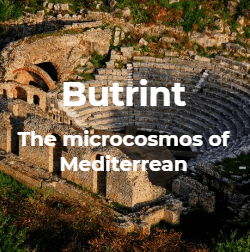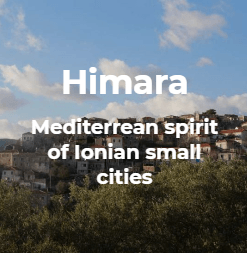Albania, a country full of history since ancient times, witness to countless battles through history. Therefore, here in Albania, you can be sure to find some spectacular castles – from ancient times to medieval fortresses. Scattered all across the country, most are steeped in history, and some are still inhabited to day. Here you will find a list with pictures of the most well-known Castles in Albania.
Rozafa Castle (Castle of Shkodra)
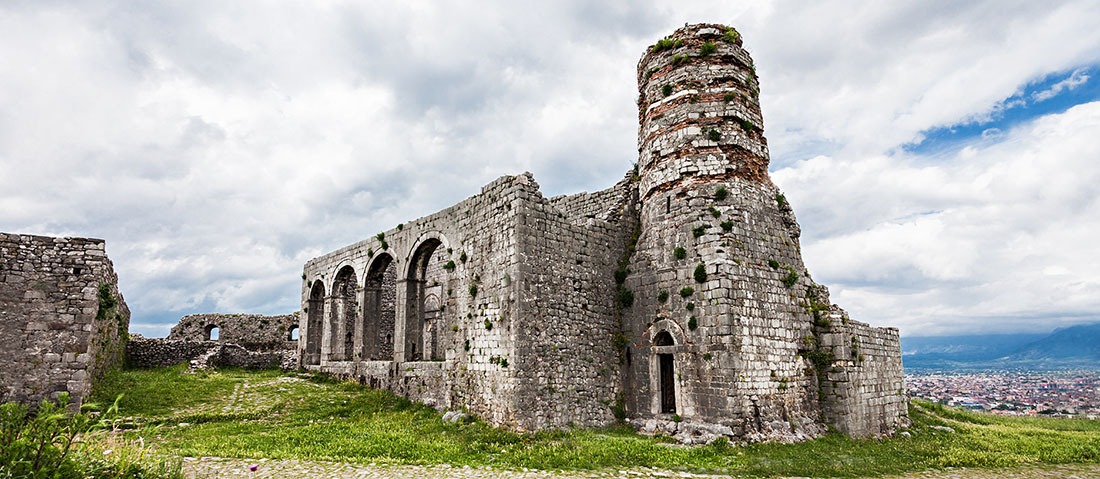
Rozafa Castle, located in Shkoder, Albania. It originates since antiquity as an Illyrian stronghold.
The Castle of Rozafa (or Shkodra Castle) is situated in a rocky hill in the west side of Shkodra city, Albania. The three rivers waters: Buna, Drini and Kiri washed the city of Shkodra. Rozafa is one of the most important castles in Albania and serves as the main tourist object in the city of Shkodra.
The Rozafa Castle is of Illyrian origins. Tit Livi, the famous historian, mentioned it as the “the strongest country of Labeati”.
The name Rozafa, comes up from the middle ages. Related to this name is based the legend, which speaks about the so called “besa – keeping the given word”. As a subject of the legend, it is the wall up of Rozafa, the youngest bride of the three brothers who build up the castle walls during the day and the walls being destroyed at night.
In the entrance of the castle it is found the Rozafa basso-relievo. Limy-stone water that flows in the main entrance represents the breast milk of Rozafa, which according to the people tradition, was left open in order to feed her baby child.
The castle shape of today was given by Balshaj feudal family, during their period of reign XIV century.
Today, most of castle’s rests belongs to the Venetians period. However, ottoman occupation has left it sings as well. Rozafa Castle’s walls have a long distance of 880 m and surrounded surface of 9 000 m2.
Ottomans occupied the Castle of Rozafa in 1479, after a strong resistance. Other objects founded inside the castle are water cisterns that date on XV century, the cathedral of XIII century which after ottoman occupation has been returned to mosque. Also inside the castle there is the Rozafa Museum that explains all the periods that the castle had to pass through.
Lezha Castle
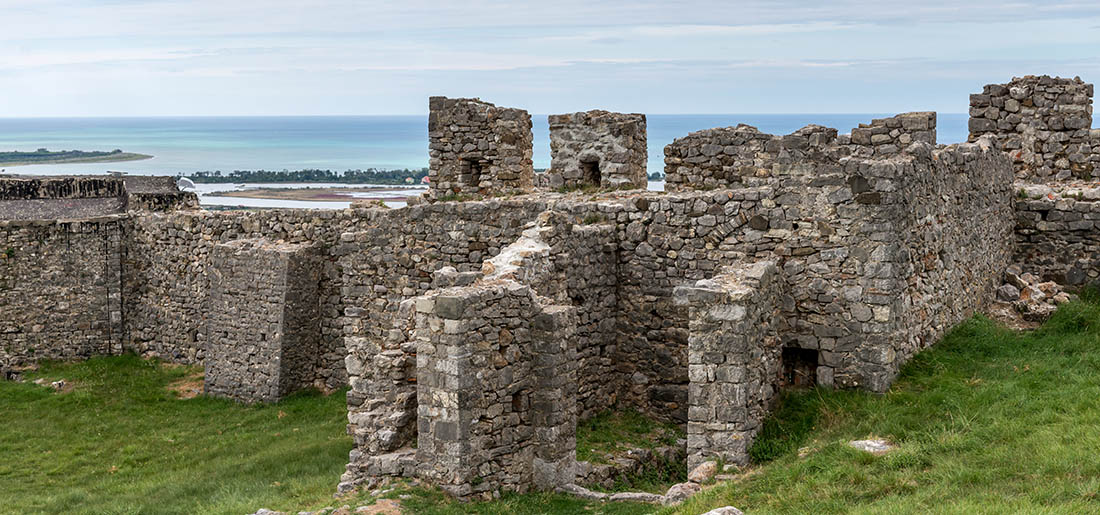
Lezha Castle, located in the city of Lezha. The castle originates from Illyrian times.
The Castle of Lezha, is another one of the many castles in Albania. It is situated on the top of the hill of 186 m high in the east part of the city. The origin of the castle is Illyrian. In the year 1440 the castle has been subject of reconstructions by Venetians, and in the 1522, after the ottoman occupation it is reconstructed also by them. Here you can find vestiges of Illyrians, Romans, Byzantines and ottomans. The most interested objects to be visited are ottomans constructions rubbles inside the castle, mosque, and the tower in the south-east wall with roman arch and Illyrian tower in the south wall of the castle. Lezha Castle is culture monument. You can see a beautiful landscape from there of Lezha country and Adriatic Sea.
Kruja Castle
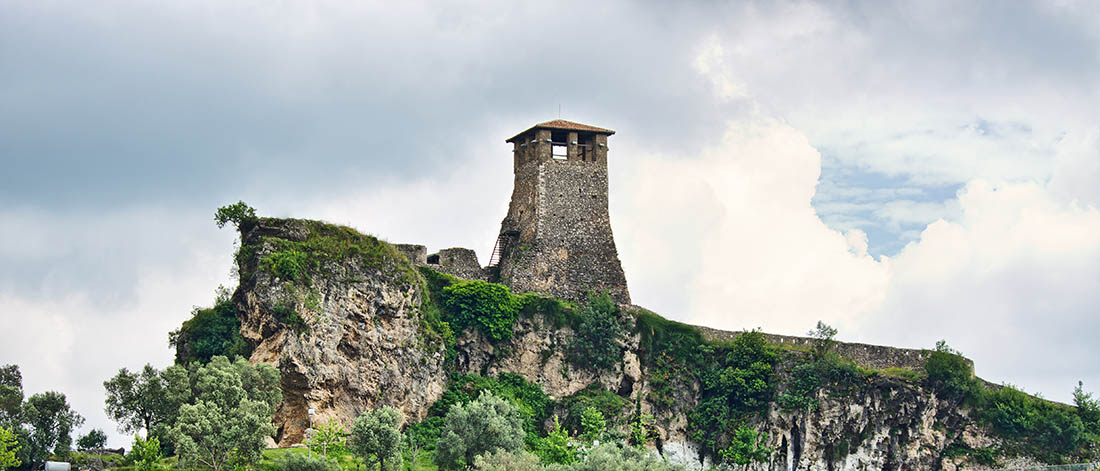
The Krujë castle is located in the city of Krujë, Albania. It was the center of Skanderbeg’s rebellion against the Ottoman Empire.
It’s the main tourist object of the city of Kruja. The Castle is constructed during V-VI centuries. The castle has an elliptic shape of 804 m perimeter. Surrounded walls are fortified with 9 towers. In the highest part of the castle, north-east part, it is constructed the Watching Tower, that served for the observation and signalisation of Petrela and Durres Castles. The Museum can be found in the main entrance of the castle which is inaugurated in 1982.
Besides the stands that explain Skanderbeg activities, in the museum you can also find bookstore, documents and publications with regard to the Skanderbeg personality. The museum has a memorial nature with such elements like stone arches, pictures in glass. etc. Inside castle walls there are houses and the small mosque of Dollmase. In the west part of the castle it is also preserved the ham am of XV century.
Tirana Fortress
Fortress of Justinian or simply known as Tirana Castle is a castle in Tirana, Albania. Its history dates back before 1300 and is a remnant from the Byzantine-era. The fortress is the place where the main east-west and north-south roads crossed, and formed the heart of Tirana.
The current fortification has three known towers and it is undergoing a process of restoration, for touristic purposes. Inside the fortified walls of the former fortress, there are many buildings that can be visited, including restaurants, hotels, and cultural institutions. About all that is left of the fortress above ground is a 6-metre (20 ft) high Ottoman-era wall, covered in vines.
The recently uncovered wall foundations were incorporated into the pedestrian Murat Toptani Street, while a mosaic commemorating the 100th Anniversary of Albania’s Independence was unveiled near the Albanian Parliament. The Castle of Tirana was declared a monument of culture of first category on 10 June 1973 and the new tracks of walls of Tirana Castle were declared a cultural monument on 15 May 2008.
Petrela Castle
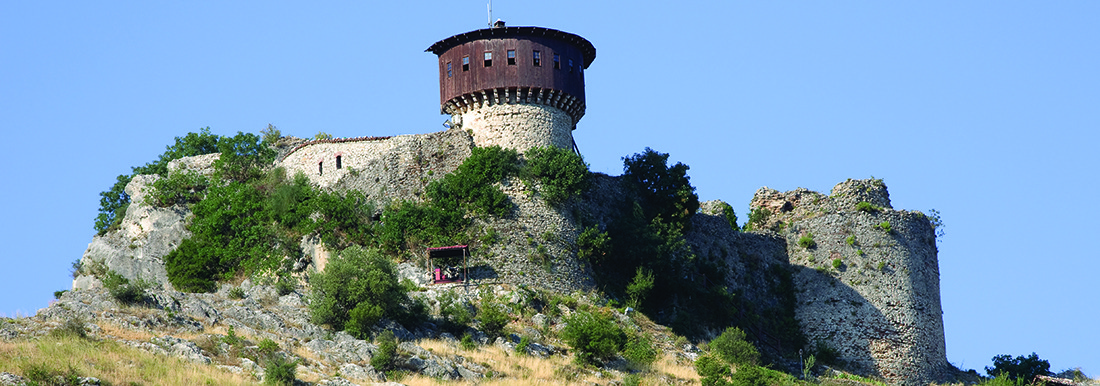
Petrela Castle is located in Petrelë. Its history dates back to Justinian I
Situated in the national street of Tirane – Elbsasan, 18 km away from the Capital of Albanian, Tirana. She is one of the most important tourist centres near by Tirana. The castle is built in rocky hill above the village to the same name. She has three-footed shape with two observation towers. Its first construction dates from the antiquity period, while today’s shape dates from XV century. Petrela Castle it was part of protection and signaller system of Kruja Castle. These two castles communicated to each-other through fire exchanges.
This castle has been under the command of Skanderbeg’s sister, Mamica Kastriotit. Today, within the castles space there are restaurants services taking place. Here hence open beautiful landscapes which go through Erzeni’s valley, hills with olives and mountains around.
Preza Castle
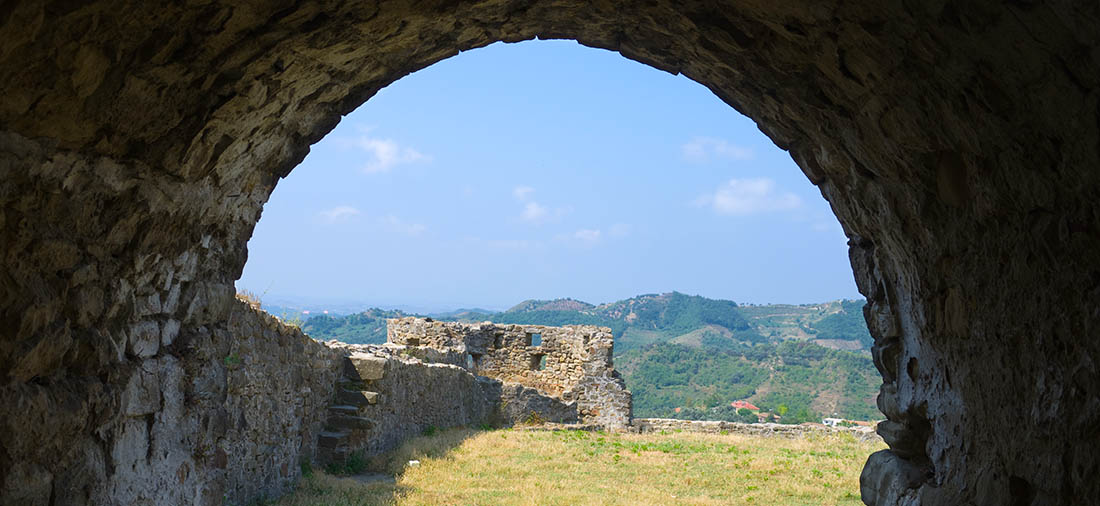
Preza Castle
It’s situated above the village to the same name, in the hill’s crest. This is a small castle which started to be constructed in the beginning in XIV century and finished in the beginning of XV century from the feudal family of the region, called Topiajve. The castle is announced ‘culture monument’. In her corners the castle has four roundly towers. The watching tower is built around years 1800 – 1850. It’s distinguished for its beautiful position that sees over Tirana field. Also in front of the tower it is situated Kruja Castle.
This Castle it is situated near by the International Airport of “Nene Tereza “in Rinas. In the castle are restaurants and service bars.
Durrës Castle
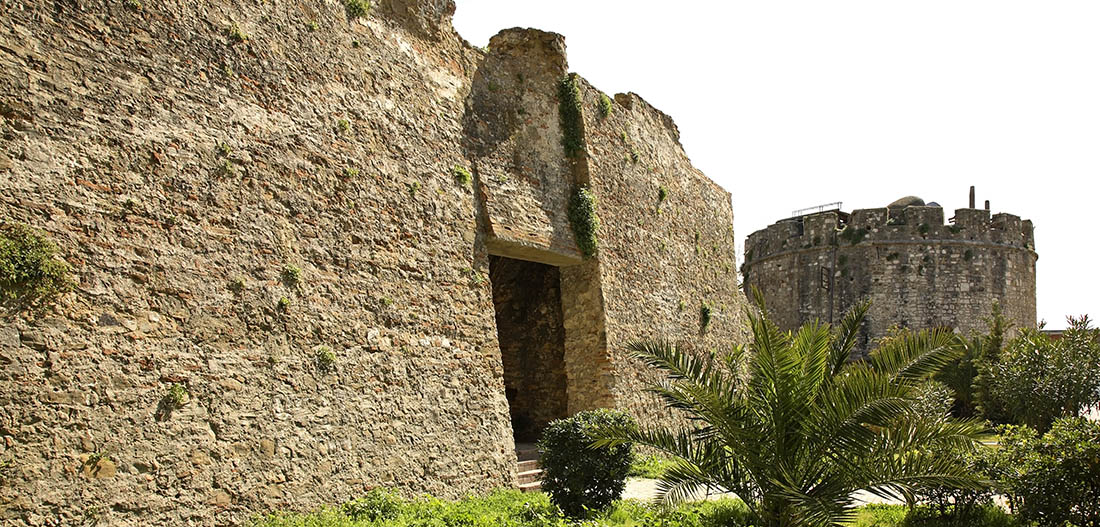
Durres Castle
Durrës Castle is a 5th-century castle, located in Durrës, Albania. The castle was built by the Emperor of the Byzantine Empire Anastasius I who originated from Durrës. At the time, Anastasius made the city one of the most fortified cities on the Adriatic. Repairs to the walls have been carried out since the devastating earthquake of 1273. Currently medieval walls nearly 15 feet (4.6 meters) in height and the three entrances of some of the fortification towers are preserved in nearly one-third of the initial length of the city castle walls.
The castle was reinforced with several guard towers by the Republic of Venice and during the occupation of Albania by Ottoman Empire the wall was reinforced.
The castle is now a popular Albanian tourist attraction in Durrës.
Rodon Castle
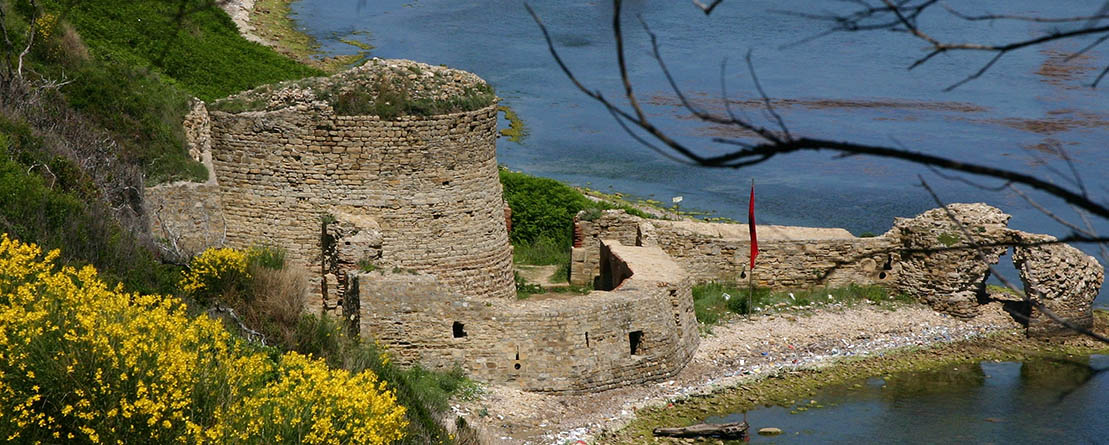
Rodon Castle
It is situated in the Rodon’s cape. The Prince, Karl Topia, wanted to transfer this place to a shipyard, meanwhile our National Skenderbeg, aiming to have a nigh cruiser built here a castle. This castle started to be built after the first Kruja embrace in year 1452. Rodon Castle’s wall is 400 m longwise and in its corners there are dungeons. In the year 1500, the castle is invaded from Venetians. As a result of abrasive activities of sea waters, the castle walls are immersed into the Adriatik Sea. Today, all the visitors can easily see the external walls in the right side that ends with a dungeon. Near by the castle you can find also rubbles of Shen Pjetrit Church, which is considered from habitants as a saint place.
Bashtova Castle

Bashtova Castle
It is situated near by the village of Bashtova in a distance of 3- 4 km in the north part of Shkumbin’s embouchure. The castle is constructed during XV century and has been in service of Venetians. Bashtova’s region is mentioned as a river port and also a centre of grain exports. The castle has quadrangular shape with 60 x 90 m dimensions. West part of the castle has been reconstructed during XVIII century. The walls are 9 m high.
Elbasan Castle
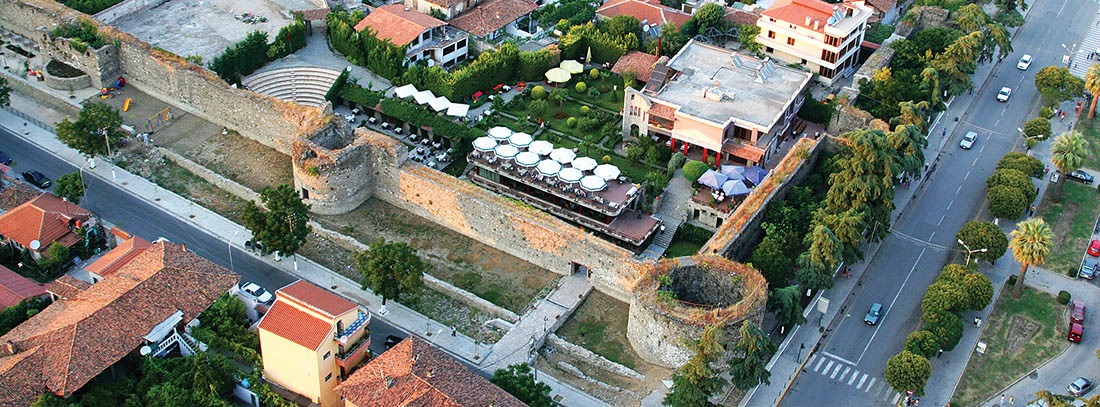
Elbasan Castle, sorrounding the city of Elbasan
It’s a field castle in the city of Elbasan. It is firstly referred by Cristobel, Second Mehemet historian. In XVIII century, the city was visited from ottomans chronicler, Evlia Celepiu, who described in details the castle. During Austrian evasion the castle became object of full studies. The Austrian’s archaeologists, Prashniker and Shober, who visited the castle during First World War and noticed that under medieval walls has fortifications of antique period. The castle has quadrangular shape with 308 x 48 m dimensions.
Today we keep saved only 8 towers from 26 that have been in the very beginning of its construction. During the late antique period the city within the castle named Skampini, started its life as habituated centre in so called “Egnatia” street. The reconstruction of castle is done by Turkeys for strategic purposes. Even today the castle is still habituated. Inside her we can still find very important Muslimism cult objects as well Christians ones.
Berat Castle
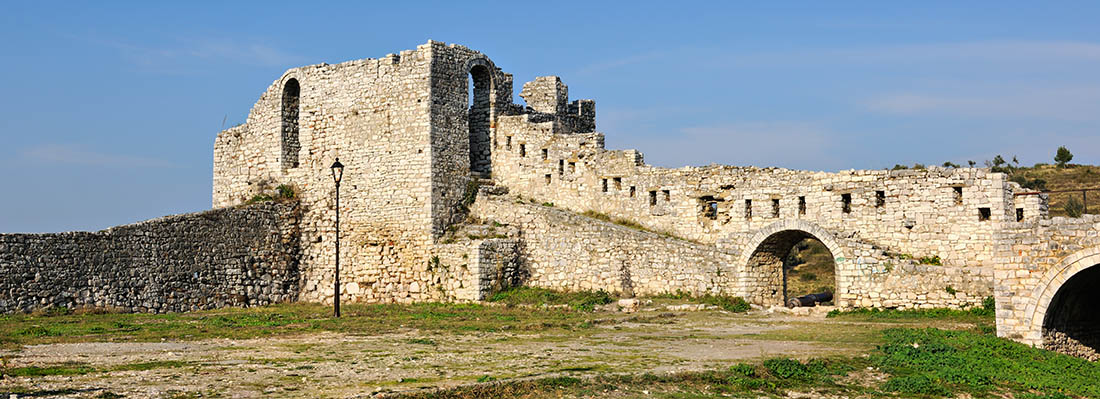
The Berat Castle is a fortress landmark in the city of Berat, Albania, which lies high above the Osum River. The castle dates back 2,500 years and records of its first conquering were accomplished by the Romans in 200 B.C. After many centuries of stone reinforcement, the exterior (perimeter) was enlarged slowly over time, under Byzantine conquerors, in the 5th, 6th, and 13th centuries. Currently the castle is in restoration due in part to a UNESCO World Heritage Site acknowledgement. (This is a welcome “gift” for the the residents of the castle who have been left under served as the city below has gotten much attention.)
Inside Berat castle houses many historical elements. A Mosque, “Red Mosque”, which can be identified by it’s lonely minaret (a staircase inside provides access to the top), more than 20 Christian churches, and a central museum which surrounds one of the largest Orthodox churches with many 16th century paintings, by “Master Onufri”, and a decorative alter inside. Many churches in Albania were destroyed during the Communist years as an “Atheist State” was declared during Enver Hoxha’s reign.
Other architectural elements are court yards, a large cistern in the center, and numerous houses of stone in which the residents of the castle still occupy today; this is an absolute specialty in castle heavy Europe as it’s one of the last remaining!
Accessing the castle easily can only be done from the Southern side. Many people who continue to live in the castle enter and exit the Southern entrance as the Northern is a drop off to the Osum River, over 100m. If entering by foot, a 200m walk up the steep cobble stone hill from downtown Berat will be rewarding. Many residents of the castle prefer to take an afternoon bus that departs from the opposite side of the city, straight through town, and up a back route.
Gjirokastra Castle
The Caslte of Gjirokastra (Albanian: Kalaja e Gjirokastrës or Kalaja e Argjirose) is a fortress in Gjirokastra, Albania. It was historically known as Argyrokastro, a name then applied also to the castle. Gjirokastra Castle is situated at a height of 336 metres (1,102 ft).
The castle dominates the town and overlooks the strategically important route along the river valley. It is open to visitors and contains a military museum featuring captured artillery and memorabilia of the Communist resistance against German occupation, as well as a captured United States Air Force plane to commemorate the Communist regime’s struggle against the “imperialist” western powers.
The citadel has existed in various forms since before the 12th century. Extensive renovations and a westward addition were added by Ali Pasha of Tepelene after 1812. The government of King Zog expanded the castle prison in 1932.
Today it possesses five towers and houses, the new Gjirokastra Museum, a clock tower, a church, a cistern, the stage of the National Folk Festival, and many other points of interest.
The castle’s prison was used extensively by Zog’s government and housed political prisoners during the Communist regime.
Ali Pasha Castle in Tepelena
Kalaja e Ali Pashës as known in Albanian is oneother Ali Pasha’s castles in Albania. It is named after Ali Pasha of Tepelenë (Ali Pasha Castle) who resided there until 1820. The current fortress was rebuilt in 1819 from its surface with 3 towers. Until 1820 it was the second residence of Ali Pashe Tepelena.
The castle described and pictured is popularly known as The Triangular Fortress. Built under Venetian dominion in the late 15th or early 16th century, it provided a stronghold for the Venetians on Corfu to exploit fishing, grazing, olives and timber in and around Butrint. The castle was the centrepiece of numerous conflicts with the burgeoning Ottoman Empire, and changed hands on several occasions. It was finally destroyed by a retreating French army in 1798 to prevent it falling in to the hands of Ali Pasha.
The fortification attributed to Ali Pasha at Butrint lies some 2.4 kilometres (1.5 mi) due west at the mouth of the Vivari Channel. This in itself began life in the late 17th or early 18th century as a fortified estate centre belonging to a Corfiote family that farmed land on the plains south of the ancient city. Ali Pasha seized control of the structure around 1804 and carried out a series of defensive improvements including the installation of gun batteries.
Given its small size it is unlikely that the fort functioned as anything more than a control over access from the sea to Butrint, and it can not be compared to Ali’s more redoubtable fortresses in the region at Tepelena, Gjirokastra and Ioannina.
Kanina Castle
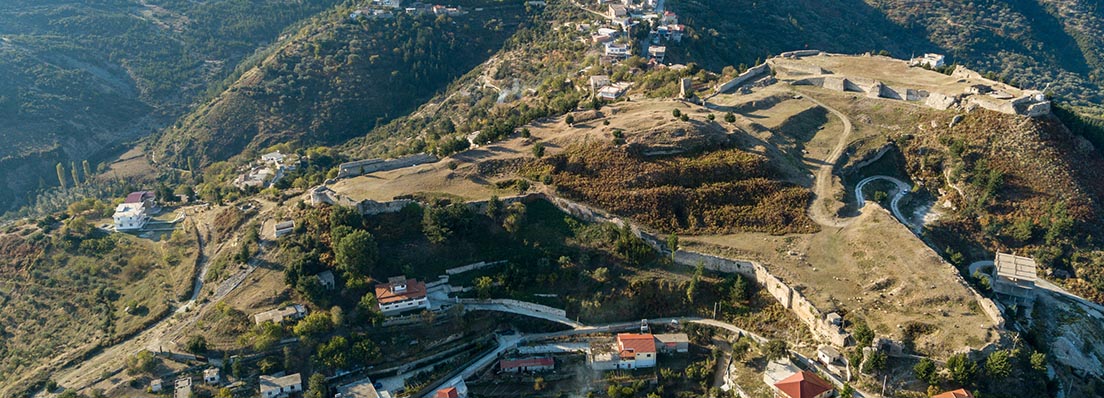
Kanina Castle
It is situated 6 km far away from city of Vlora. This castled is mentioned since IV A.D century, even if there are discovered signs of Illyrian period. There is a thought that the castle has been constructed since III B.C century. Posterior signs belong to Byzantine, Venetians and Turkey’s period. The castle has been reconstructed from Justiniani in V A.D century and afterwards been repaired from Sultan Sulejmani in 1531. The castle is situated on the top of the hill of 380 m high above sea-level. She has a surface of 3600 m2. Beautiful landscapes can be viewed from the castle towards Vlora city.
Ali Pasha Castle in Porto Palermo Bay

Ali Pasha Castle in Porto Palermo Bay
It is a small castle situated in a very beautiful position in a peninsula in a small tectonic bay of Porto Palermo (knowed in antiquity as Bay of Panormes). The castle is no far from Qeparo village and has a pentagonal shape. Her dimensions are 150 x 400 m. The walls are 20 m high. Ali Pasha, constructed this castle in honour of his wife, Vasiliqise, as well to serve as control point.
Himara Castle
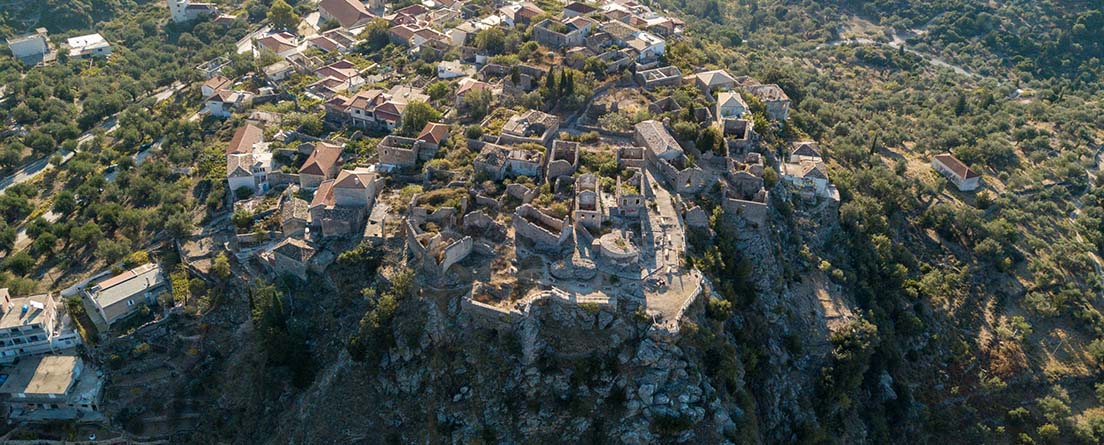
Himara Castle
It is impossible to become fully acquainted with the southern village of Himara without visiting the place where its memory is stored: the Himara Castle. Beautifully surrounded by the Ceraunian Mountains in the north and the spectacular Ionian Sea in the south, the Himara Castle offers a rare journey into Albanian history and breathtaking nature.
In antiquity, the city was known by the name of Chimera. Its fortification began during the 8th century B.C. and, while it was restored various times, its most significant reconstruction occurred during the 6th century, A.D., under the rule of Justinian, emperor of the Byzantine Empire.
With the castle becoming the center of the Bishopric of Himara during the 8th century, many churches were built inside and outside of it, some of them still standing and well worth seeing! The most famous one among them is the Episcopal Church (Kisha e Episkopisë), displaying a beautiful sculpture of the Albanian symbol of the two-headed eagle on one of its gates. For the map, click here.
Borsh Castle
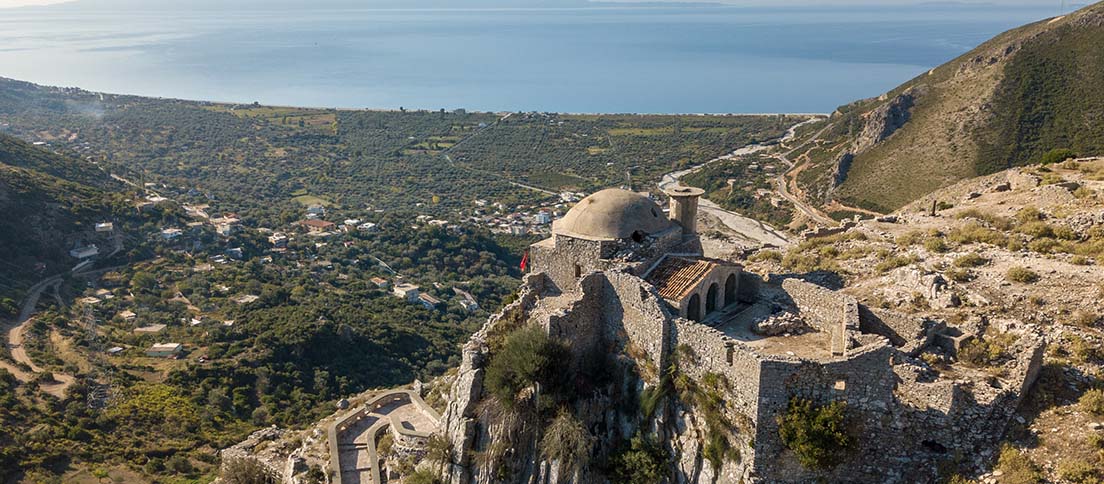
Borsh Castle also known as Sopot Castle (Albanian: Kalaja e Sopotit) is a ruined castle near the village Borsh, Albania.This castle is also known as the Castle of Sopot by the name of the hill on which it is located.It was built in the fourth century BC. The castle was heavily damaged during the barbarian invasions of the fifth and sixth centuries AD, and it was rebuilt in the Middle Ages at which time it took its present name.
Lëkursi Castle
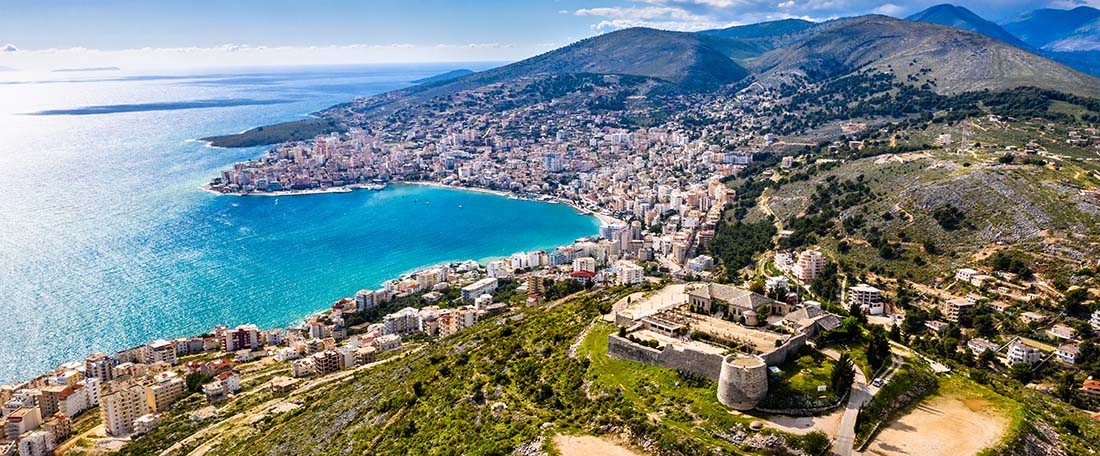
Lekursi Castle
It is situated 2 km on the south part of Saranda city. The castle has quadrangular shape where there is a tower in each corner. According to some quarries the castle is constructed in year 1537 from Sulejman Sultan, during his invasion campaign into Korfuz Island. The castle is situated into a very upmost hill ad offers a beautiful view. In the castle there is a restaurant.
Ali Pasha’s Vivari Castle
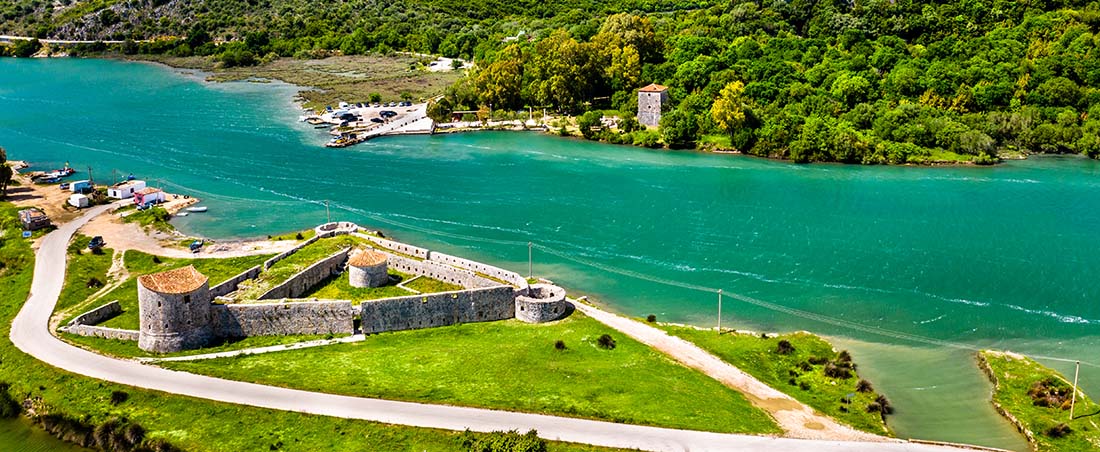
Ali Pasha Vivari Castle
While visiting the famous Butrint Archaeological site, don’t forget to stop at the Castle of Vivari, located at the front entrance of Butrint. The castle’s famous triangular shape is surrounded by round towers in all corners of the castle. Thought to have been built during the 13th century, this castle has been reconstructed various times in the following centuries, most famously by the Venetians and Ali Pashë Tepelena. This is one of the smaller of Tepelena’s famous castles scattered throughout the south. However, this fortress holds a certain Venetian charm that is worth witnessing.







